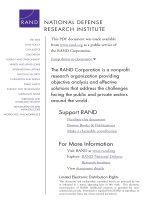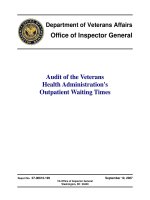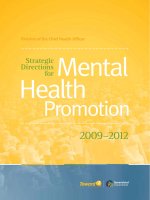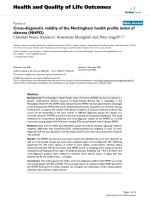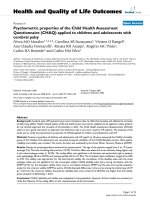Division of the Chief Health Officer Strategic Directions for Mental Health Promotion 2009–2012 pptx
Bạn đang xem bản rút gọn của tài liệu. Xem và tải ngay bản đầy đủ của tài liệu tại đây (478.16 KB, 20 trang )
2009–2012
Promotion
Mental
Health
Strategic
Directio ns
fo r
Division of the Chief Health Offi cer
Strategic Directions for Mental Health Promotion 2009–2012
Strategic Directions for Mental Health Promotion 2009–2012 is part of a suite of planning and reporting documents
which describe the work of the population health services within the Division of the Chief Health Officer.
The complete suite includes:
Population Health Year in Review 2008–2009
■
Prevention, Promotion and Protection Plan for the Division of the Chief Health Officer 2009–2014
■
Strategic Directions for Cancer Prevention and Control 2009–2012
■
Strategic Directions for Chronic Disease Prevention 2009–2012
■
Strategic Directions for Communicable Disease Prevention and Control 2009–2012
■
Strategic Directions for Environmental Health 2009–2012
■
Strategic Directions for HIV/AIDS, Hepatitis C and Sexual Health 2009–2012
■
Strategic Directions for Injury Prevention and Safety Promotion 2009–2012
■
Strategic Directions for Mental Health Promotion 2009–2012
■
Strategic Directions for Quality Management 2009–2012
■
Strategic Directions for Mental Health Promotion 2009–2012
Division of the Chief Health Officer
Published by Queensland Health
August 2009
ISBN 978-1-921447-79-2
© The State of Queensland (Queensland Health) 2009
The Queensland Government supports and encourages the dissemination and exchange of information. However, copyright protects
this material. The State of Queensland has no objection to this material being reproduced made available online or electronically,
but only if it is recognised as the owner and this material remains unaltered. Inquiries to adapt this material should be addressed
by email to: or by mail to: The IP Officer, Office of Health and Medical Research, Queensland Health,
GPO Box 48, BRISBANE QLD 4001.
An electronic copy of this document is available at:
www.health.qld.gov.au/ph
Preferred citation: Queensland Health (2009) Strategic Directions for Mental Health Promotion 2009–2012
Division of the Chief Health Officer
Queensland Government, Brisbane
Strategic Directions for for Mental Health Promotion 2009–2012
i
Message from the Chief Health Officer
Queenslanders are generally very healthy compared
to people in other parts of Australia and the world.
However, there is still a range of population health
challenges that need to be addressed. The rate of
chronic diseases (such as diabetes, heart disease
and cancer) is growing, and substantial inequalities
in health status for Aboriginal and Torres Strait Islander
people, socioeconomically disadvantaged people and
those living in rural and remote locations continue to
be of concern.
The Division of the Chief Health Officer is the primary
provider of prevention, promotion and protection
services for Queensland Health. These services are
known collectively as population health or public health
services, and are provided by statewide branches and
units and 17 population health units located throughout
the state.
Population health services work toward achieving
a positive and healthy future for all Queenslanders,
including reducing the health status gap between the
most advantaged and the least advantaged people in
the community.
Responsibilities of Queensland Health’s population
health services include implementing health
promotion interventions at the state and local level,
undertaking health surveillance and disease control
initiatives, developing and implementing public health
legislation, and addressing environmental health
hazards. Population health services are provided by
a professional workforce comprising environmental
health officers and scientists, health promotion officers,
public health officers, epidemiologists, public health
nurses, public health nutritionists, public health medical
officers, immunisation nurses and physicists.
Population health staff work with a range of partners
including local government, private industries,
educational institutions, childcare providers, and other
state government departments. These partners have
an important role to play in creating physical and social
environments which prevent illness and injury and
promote health and wellbeing.
Our strategies contribute to Queensland Health’s
commitments under the National Partnership Agreement
on Preventive Health, and the National Indigenous
Reform Agreement. The Queensland Government’s
vision for 2020 has been described in Toward Q2:
Tomorrow’s Queensland in terms of five ambitions. One
of these ambitions is ‘making Queenslanders Australia’s
healthiest people’. Our work will contribute significantly
to this aspiration.
The complete body of work that the Division’s population
health services will undertake over the next three years
is identified in our eight strategic directions documents.
These documents outline how we will contribute to the
Q2 target. They also describe the current and proposed
approach to manage health risks, and to prevent and/or
respond to public health events. The arrival in Australia
of Pandemic (H1N1) 2009 (Human Swine Influenza) acts
as timely reminder of the need for meticulous health
protection planning and response.
I trust that you find these strategic directions documents
informative. For our staff, I hope these documents will
enable us to work together to address priority issues
over the next three years. For our stakeholders, I hope
these documents give you an insight into our future
directions to facilitate collaborative actions across a
range of issues. I look forward to continuing to work with
you all to promote and protect the health and wellbeing
of Queenslanders.
Dr Jeannette Young
Chief Health Officer, Queensland Health
Strategic Directions for Mental Health Promotion 2009–2012
ii
Strategic Directions for for Mental Health Promotion 2009–2012
iii
Contents
Message from the Chief Health Officer i
Vision iv
Introduction 1
What are we seeking to achieve over the next three years? 2
Strategic agenda 3
1. Organisational capacity 3
2. Supportive environments for positive mental h
e
alth: workplaces, children, communities 4
Attachment A: Deliverables for 2009–2010 6
Attachment B: Ongoing work roles and responsibilities 9
References 11
Strategic Directions for Mental Health Promotion 2009–2012
iv
A consistent,
statewide approach to promoting
positive mental health
Vision
Strategic Directions for for Mental Health Promotion 2009–2012
1
Although current definitions of positive mental health
vary, it is frequently conceptualised as encompassing
aspects of emotional (feelings), psychological (positive
functioning), social (relations with others and society),
physical (physical health) and spiritual (sense of
meaning and purpose in life) wellbeing
2
. Optimal
positive mental health has consistently been found
to be associated with physical health and longevity,
less mental illness (including anxiety, depression,
schizophrenia and personality and substance abuse
disorders), protective health behaviours, productivity
and social engagement
2
.
The Queensland Framework for Mental Health Promotion
identifies positive mental health as the primary focus
for mental health promotion in Queensland. The
framework also highlights the links between positive
mental health, mental illness prevention and chronic
disease prevention. For example, participation in regular
physical activity is linked to all three outcomes, with
many strategies identified in the Strategic Directions
for Chronic Disease Prevention 2009–2012 contributing
to positive mental health, and vice versa. These two
outcome areas share a common interest in building
physical and social environments that support the
adoption of healthy lifestyle behaviours and
promote positive mental health across all stages
in a person’s life.
Over the next three years, population health
services within the Division of the Chief Health Officer
will develop and implement a sustainable, evidence
based mental health promotion service delivery model
which enables and supports positive mental health in
the community, including improving social, emotional,
cultural and spiritual wellbeing among Aboriginal and
Torres Strait Islander peoples.
Strategic Directions for Mental Health Promotion
2009–2012 will contribute to the goals and objectives
of the following key national and state policies,
strategies and plans:
Primary
Toward Q2: Tomorrow’s Queensland
■
4
National Partnership Agreement on Preventive Health
■
3
Secondary
National Action Plan on Mental Health 2006–2011
■
5
National Mental Health Policy 2008
■
A National Strategic Framework for Aboriginal and
■
Torres Strait Islander Peoples’ Mental Health and
Social and Emotional Well Being 2004–2009
6
Healthy Children – Strengthening Promotion and
■
Prevention Across Australia: National Public Health
Strategic Framework for Children: 2005–2008
7
National Action Plan for Promotion, Prevention and
■
Early Intervention for Mental Health 2000
8
4
■
th
National Mental Health Plan (currently in draft)
Strategic Policy for Aboriginal and Torres Strait
■
Islander Children and Young People’s Health:
2005–2010
9
Strategic Policy Framework for Children and Young
■
People’s Health 2002–2007 (still current)
10
.
Queensland Plan for Mental Health 2007–2017
■
11
Protecting children is everyone’s business: National
■
Framework for Protecting Australia’s Children
2009–2020
12
.
Queensland Framework for Mental Health Promotion
■
13
Positive mental health is a key factor in population wellbeing and long-term social and
economic prosperity. The World Health Organization defines mental health as a ‘state of
wellbeing in which the individual realises his or her abilities, copes with the normal stresses
of life, works productively and fruitfully, and makes a contribution to his or her community’
1
.
Therefore, positive mental health has a broader focus than the absence
of mental health problems or disorders.
Introduction
Strategic Directions for Mental Health Promotion 2009–2012
2
What are we seeking to achieve over
the next three years?
This document identifies priority actions for promoting mental health over the next three
years. Overall progress against these actions will be assessed using the measures outlined
below. Performance will be assessed through qualitative reporting. Annual reporting will
inform decisions about policy, practice and future investment.
What we are seeking to achieve How will we know?
Enhanced positive mental health among
Qu
eenslanders
Percentage and number of Queensland population
■
who report positive mental health
Integration of mental health promotion objectives
into mainstream health promotion initiatives in a
range of settings
Number of chronic disease prevention initiatives that
■
explicitly acknowledge integration of mental health
promotion objectives and measure mental health
promotion outcomes (by population health unit)
Strategic Directions for for Mental Health Promotion 2009–2012
3
Strategic agenda
1. Organisational capacity
*
To achieve a consistent, statewide approach to positive mental health, our population
health services will focus on developing capacity to promote and support initiatives across
the life course. This includes a focus on both the ability to effectively perform mental health
promotion functions, and the ability to work with other sectors whose business contributes
to positive mental health outcomes.
The Queensland Framework for Mental Health Promotion
provides a foundation on which to develop a service
delivery model for mental health promotion that includes
contexts, priority groups, interventions and workforce
roles and responsibilities. The service model will also
clarify implementation issues including communication,
data monitoring and reporting, quality improvement and
evaluation, governance, professional development, and
coordination and integration with other services.
Developing our service model will be a staged process,
taking into account current opportunities to embed
mental health promotion activities within a broader
strategic agenda for chronic disease prevention.
Common risk and protective factors (eg. participation
in physical activity) and common target groups
and settings (healthy children, workplaces, and
communities) create strong links between these two
outcome areas. Strategies to be implemented under
Strategic Directions for Chronic Disease Prevention
2009–2012 will support the promotion of positive
mental health.
In 2007, Health Promotion Queensland funded an expert
consortium to develop a framework that defines social,
emotional, cultural and spiritual wellbeing among
Aboriginal and Torres Strait Islander peoples. The final
report from this consortium was delivered in May 2009.
Our challenge now is to develop an effective response
to the key directions and recommendations of this report
to build the capacity of the Division and our key partners
and stakeholders to implement priority mental health
promotion strategies.
The Queensland Centre for Mental Health Promotion,
Prevention and Early Intervention (QCMHPPEI) was
established in 2008. The QCMHPPEI will contribute to
the development, analysis, implementation, and review
of mental health promotion, prevention, and early
intervention policy and practice in Queensland. The
Division’s mental health promotion services will seek
opportunities for strategic alignment with the direction
provided by QCMHPPEI and to establish a clear working
relationship.
What are we going to do over the next
three years?
Finalise the
■
Queensland Framework for Mental Health
Promotion
Develop and implement a mental health promotion
■
service delivery model for the Division’s population
health services
Develop and implement a response to the
■
recommendations and key directions identified in the
report Key directions for a social, emotional, cultural
and spiritual wellbeing population health framework
for Aboriginal and Torres Strait Islander Australians
in Queensland
Define the working relationship between mental
■
health promotion staff and the Queensland Centre
for Mental Health Promotion, Prevention and
Early Intervention, and develop integrated and
complementary programs of work
Develop appropriate mental health promotion
■
measures for service delivery performance and
strategic reporting requirements.
* Organisational capacity is taken to encompass the systematic processes required to implement effective change (in beliefs,
attitudes, values, skills, structure, systems, processes, policies, procedures, programs, networks, partnerships) to improve an
organisation’s ability to achieve its strategic purpose.
Strategic Directions for Mental Health Promotion 2009–2012
4
2. Supportive environments for positive mental health: workplaces,
children, communities
The National Partnership Agreement on Preventive Health
3
seeks to assist Australians to
reduce their risk of chronic disease by creating supportive environments for children and
in workplaces and communities. This provides an opportunity to integrate mental health
promotion activities within the broader strategic approach to chronic disease prevention
and to promote healthy behaviours across the life course.
Good evidence exists about the links between positive
mental health and the prevention of chronic disease.
People with optimal mental health have been found to
have fewer chronic physical diseases including stroke
and heart disease
14
and to live longer
15
. They are
also less likely to engage in health risk behaviours
(eg. tobacco, alcohol and drug misuse, unsafe sex)
and are more likely to feel motivated to exercise choice
and control and adopt a healthy lifestyle
14,15
.
Healthy workplaces
A recent review of stress management and wellbeing
interventions in the workplace
16
found that the most
promising initiatives:
involve interventions that focus on both people
■
and the organisation
involve trained specialists in health and
■
organisational development
have strong and sustained support from
■
management.
The review also found that well-designed evaluation
of workplace interventions is rare, and a more thorough
documentation of processes is needed. The Division’s
health promotion services have a renewed focus on
promoting positive mental health in the workplace,
and will conduct further research into successful
interventions to identify options for the effective and
efficient implementation of statewide policies and
programs.
Healthy children
The World Health Organization recognises the quality
of the early years as a key social determinant of health
17
.
There are sound theoretical and empirical reasons
for focusing mental health promotion interventions
on young children to prevent a range of problems in
later life
18
including mental health problems, obesity,
criminality, family violence, poor literacy, unemployment
and welfare dependency. Prevention and early
intervention is also less expensive and more effective
than treatment
19
.
In recent years, the Division’s health promotion
services have invested in a number of universal and
targeted multi-strategy interventions to improve
social and emotional wellbeing in early childhood.
These interventions have been conducted with the
early childhood education and care sector, child care
centres, training institutions and communities. It is
now time to capitalise on this investment; promote the
availability of effective tools, resources and programs;
and consider the most effective approaches to sustained
implementation.
Research into the mental health needs of children
and young people has established that good practice
interventions in school settings can have a positive
influence on mental health and wellbeing, and that the
school setting is a critical supportive environment
20
.
Evidence shows that whole-of-school approaches
involving changes to the school environment, personal
skills development in class and parental participation
are more effective than purely classroom-based
programs
20
.
Strategic Directions for for Mental Health Promotion 2009–2012
5
Healthy communities
Social inclusion and social support are recognised as
key social determinants of health
17
. The Heart
Foundation has found strong and consistent evidence
that people who are socially isolated or lacking quality
social support are more likely to develop coronary heart
disease, and that social support and social isolation can
affect the recovery and future health of people who
already have heart disease
21
. Evidence also shows a
strong link between social capital, sense of community
belonging, community participation, a culture of
cooperation and tolerance, and positive mental health
2
.
Participation in physical activity has specific additional
benefits for positive mental health. Our health
promotion services have a focus on increasing physical
activity, and are using a healthy active ageing approach
to chronic disease prevention and falls prevention for
older adults. This approach presents the opportunity to
integrate mental health promotion perspectives and
objectives into other health promotion initiatives
specifically targeting older people.
Over the next three years, an integrated approach to
deliver mental health promotion interventions in
workplaces, school communities, child care programs,
maternal health programs, healthy active ageing
partnerships and local community settings will be
developed. We will also consolidate and build on
existing achievements by developing policies,
strategies, resources, and programs that promote
positive mental health.
What are we going to do over the next
three years?
Healthy workplaces
Review the evidence for effective mental health
■
promotion in workplace settings
Identify current good practice interventions
■
and assess options
Develop and implement agreed policies and programs
■
statewide.
Healthy children
Integrate mental health promotion processes and
■
outcomes into a structured approach to creating
supportive environments in the early years,
including working with a range of partners from
the early childhood education and care sector
to facilitate adoption
Investigate and define the potential for the
■
Division’s population health services to strategically
support community responses to Australian Early
Development Index (AEDI) data
Evaluate the work of the Division’s health promotion
■
services on social and emotional wellbeing in
the early years, and progress recommendations
for the most effective approaches to sustain
implementation.
Healthy communities
Implement the National Partnership Agreement
■
Healthy Communities Initiative to facilitate social
inclusion outcomes, in collaboration with the
Australian Government
Develop and implement a consistent approach to
■
integrating mental health promotion perspectives
and outcomes into physical activity and healthy active
ageing initiatives.
Strategic Directions for Mental Health Promotion 2009–2012
6
What are we going to do?
(3 years)
Statewide unit responsibilities
(12 months)
Popultion health unit responsibilities
(12 months)
1. Organisational capacity
1.1 Finalise the Queensland
Framework for Mental
Health Promotion
Lead the finalisation of the framework
1.2 Develop and implement
a response to the
recommendations and
key directions identified
in the report Key
directions for a social,
emotional, cultural
and spiritual wellbeing
population health
framework for Aboriginal
and Torres Strait
Islander Australians in
Queensland
Lead the development of a response to
the recommendations in Key directions
for a social, emotional, cultural
and spiritual wellbeing population
health framework for Aboriginal and
Torres Strait Islander Australians in
Queensland
1.3 Define the working
relationship between
mental health promotion
staff and the Queensland
Centre for Mental Health
Promotion, Prevention
and Early Intervention
(QCMHPPEI), and
develop integrated
and complementary
programs of work
Define the working relationship
between mental health promotion
staff and the QCMHPPEI
Identify opportunities for integrated
and complementary work (in
collaboration with the population
health units and QCMHPPEI)
Identify opportunities for integrated
and complementary work with
QCMHPPEI (in collaboration with
the statewide unit)
1.4 Develop appropriate
mental health promotion
measures for service
delivery performance
and strategic reporting
requirements
Facilitate a process to establish
agreed statewide positive mental
health indicators (tier 1 and 2) as per
Prevention, Promotion and Protection
Health Performance Information Needs
2009–2012
Lead the development of mental
health promotion measures (tier 3)
for service delivery planning and
reporting
Attachment A
Deliverables for 2009–2010
*
* This attachment includes deliverables against the reform agenda only. Ongoing work is described in Attachment B. All population
health strategies are conducted in a collaborative manner. Lead agencies have been identified in the responsibilities columns.
Strategic Directions for for Mental Health Promotion 2009–2012
7
What are we going to do?
(3 years)
Statewide unit responsibilities
(12 months)
Popultion health unit responsibilities
(12 months)
2. Supportive environments for positive mental health: workplaces, children, communities
2.1 Review the evidence for
effective mental health
promotion in workplace
settings
Coordinate a review of the evidence for
effective mental health promotion in
the workplace
Undertake elements of the review
of the evidence for effective mental
health promotion in the workplace
2.2 Identify current good
practice interventions,
and assess options
Collaboratively identify options for
investment
2.3 Integrate mental health
promotion processes
and outcomes into a
structured approach
to creating supportive
environments in the
early years, including
working with a range of
partners from the early
childhood education and
care sector to facilitate
adoption
Lead the development of a structured
approach to creating supportive
environments in the
early years
2.4 Investigate and define
the potential for the
Division’s population
health services to
strategically support
community responses
to Australian Early
Development Index
(AEDI) data
Develop an options paper on an
agreed role for population health
services, in consultation with
jurisdictions and departments
Strategic Directions for Mental Health Promotion 2009–2012
8
What are we going to do?
(3 years)
Statewide unit responsibilities
(12 months)
Popultion health unit responsibilities
(12 months)
2. Supportive environments for positive mental health: workplaces, children,
communities (continued)
2.5 Evaluate the work of
the Division’s health
promotion services on
social and emotional
wellbeing in the early
years, and progress
recommendations
for the most effective
approaches to sustain
implementation
Evaluate early years initiatives
including:
– language and literacy initiatives
in rural and remote locations
[Southern, Central]
– Social and Emotional Early
Development Strategy (SEEDS)
statewide [Southern]
– statewide distribution of early years
resources [Southern]
– Starting Strong [Central]
– Mental Health Promotion resource
for prenatal to five years [Central]
2.6 Implement the
National Partnership
Agreement Healthy
Communities Initiative
to facilitate social
inclusion outcomes, in
collaboration with the
Australian Government
Participate in the Healthy Communities
Initiative Project Steering Committee
Support the Healthy Communities
Initiative trial communities in
Queensland
Support the Healthy Communities
Initiative trial communities in
Queensland
2.7 Develop and implement
a consistent approach to
integrating mental health
promotion perspectives
and outcomes into
physical activity and
healthy active ageing
initiatives
Coordinate the development of
an agreed statewide approach to
integrating mental health promotion
perspectives and outcomes into
physical activity and healthy active
ageing initiatives, building upon the
Be Kind To Your Mind project
Develop tools to support a consistent
statewide approach to integrating
mental health promotion into physical
activity and healthy active ageing
initiatives
Strategic Directions for for Mental Health Promotion 2009–2012
9
Attachment B
Ongoing work roles and responsibilities
Statewide unit responsibilities Population health unit responsibilities
1. Mental health promotion interventions
Advocate for the ongoing implementation of
established mental health promotion initiatives
(eg. Kids Matter and MindMatters)
Contribute to planning and development processes
for statewide projects
Contribute to planning and development processes
led by the statewide unit including:
– finalisation of the Queensland Framework for Mental
Health Promotion
– development of a complementary work program with
the QCMHPPEI
– development of a structured approach to creating
supportive environments in the early years
Support the implementation of evidence based
mental health promotion initiatives, including:
– Healthy Bodies Healthy Minds
– SEEDS
– Helping Friends
– MindMatters
– Kids Matter
– Starting Strong
2. Mental health promotion research
Present mental health promotion work at conferences
and forums (as appropriate)
Identify research priorities for mental health promotion
Present mental health promotion work at conferences
and forums (as appropriate)
Contribute to evidence base by publishing mental health
promotion work in peer review publications identifying
key learnings
Strategic Directions for Mental Health Promotion 2009–2012
10
Statewide unit responsibilities Population health unit responsibilities
3. Mental health promotion partnerships
Participate in governance mechanisms for external
projects including actively contributing to the
MindMatters and Kids Matter Queensland reference
group
Build and maintain relationships with early childhood
education and care sector (including peak bodies)
and service providers (including child care centres),
non-government agencies, community groups and
local governments
Contribute to intra-agency and inter-agency committees
and other relevant groups including:
– Mental Health Promotion, Prevention and Early
Intervention (MHPPEI) Subgroup of the Mental
Health Clinical Network
– Mental Health Literacy Working Group
– Ed-LinQ
Support the establishment and ongoing work of the
MHPPEI Subgroup, and other relevant mental health/
healthy active ageing/physical activity/healthy
communities networks and working groups at the
regional and local level
Progress and review healthy baby partnerships with
key stakeholders as locally appropriate, to increase the
adoption of agreed mental health promotion actions
[Central]
Provide information on mental health promotion
initiatives to existing networks of early years
stakeholders, including Early Years Network and
Communities for Children
Facilitate networking and partnership opportunities
with local early years service providers (eg. Early Years
Forums, Communities for Children)
Continue to develop and progress consistent healthy
messages for parents of infants in partnership with
Healthy Baby Clusters (exploring application of Small
Talk) [Central]
Strategic Directions for for Mental Health Promotion 2009–2012
11
World Health Organisation 2001, 1. The World Health
Report 2001 – Mental Health: New Understanding,
New Hope, WHO, Geneva.
Barry, M & Friedli, L. 2008 2. State-of-Science Review:
SR-B3 The influence of social, demographic and
physical factors on positive mental health in children,
adults and older people. Review commissioned as
part of the UK Government’s Foresight Project,
Mental Capital and Wellbeing, [Online] Available at
Capital/SR-
B3_MCW.pdf.
Council of Australian Governments. 2008, 3. National
Partnership Agreement on Preventive Health,
[Online] Available at: />intergov_agreements/federal_financial_relations/
docs/national_partnership/national_partnership_
on_preventive_health.pdf.
Queensland Government. 2008, 4. Toward Q2:
Tomorrow’s Queensland, Queensland Government,
Brisbane.
Council of Australian Governments. 2006, 5.
National Action Plan on Mental Health 2006–2011,
[Online] Available at: />meetings/140706/docs/nap_mental_health.pdf.
Social Health Reference Group. 2004, 6. A National
Strategic Framework for Aboriginal and Torres Strait
Islander Peoples’ Mental Health and Social and
Emotional Well Being 2004–2009, [Online] Available
at: />publishing.nsf/Content/8E8CE65B4FD36C6DCA2572
2B008342B9/$File/wellbeing.pdf.
National Public Health Partnership. 2005, 7. Healthy
Children – Strengthening Promotion and Prevention
Across Australia: National Public Health Strategic
Framework for Children: 2005–2008, [Online]
Available at: />chip/documents/CHIPFramework14Sept05web.pdf.
Commonwealth Department of Health and Aged Care. 8.
2000, National Action Plan for Promotion, Prevention
and Early Intervention for Mental Health 2000, [Online]
Available at: />wcms/Publishing.nsf/Content/EF1F6AF1B2554334CA
25720D001ADDA8/$File/promote.pdf.
Queensland Health 2005, 9. Strategic Policy for
Aboriginal and Torres Strait Islander Children and
Young People’s Health: 2005–2010, [Online] Available
at: />corporate/strategicpolicies/spatsicyph.pdf.
Queensland Health. 2002, 10. Strategic Policy Framework
for Children and Young People’s Health 2002–2007,
[Online] Available at: />publications/childhealth/16008.pdf.
Queensland Health. 2008,11. The Queensland Plan
for Mental Health 2007–2017, [Online] Available at:
/>qpfmh/p1.asp.
Council of Australian Governments. 2009, 12. Protecting
children is everyone’s business: National Framework
for Protecting Australia’s Children 2009–2020,
[Online] Available at: />coag_meeting_outcomes/2009-04-30/docs/child_
protection_framework.pdf.
Queensland Health. 13. Queensland Framework for Mental
Health Promotion (in development).
GermAnn, K & Ardiles, P. 2008, 14. Towards Flourishing
for All: Mental Health Promotion and Mental Illness
Prevention Policy Background Paper. Commissioned
by the Pan-Canadian Planning committee for the
National Think Tank on Mental Health Promotion.
[Online] Available at: />mentalhealthpdf/Toward%20Flourishing%20For%20
All%20Background.pdf.
Friedli, L & Parsonage M. 2007, Building an economic 15.
case for mental health promotion: part 1, Journal of
Public Mental Health, 6 (3), pp 14–23.
References
Strategic Directions for Mental Health Promotion 2009–2012
12
Semmer, N K. 2008, 16. Mental capital and wellbeing:
Making the most of ourselves in the 21st century
[Online] Available at: />Mental%20Capital/SR-B3_MCW.pdf.
Wilkinson, R & Marmot, M (Eds). 2003, 17. Social
Determinants of Health: The Solid Facts. 2nd Edition,
[Online] Available at: />document/e81384.pdf.
Armstrong, R, Waters, E, Davis, E, Harper, C & 18.
Priest, N. 2007, The Development of Evidence Based
Recommendations to Support Policy and Practice.
A Report Prepared for Population Health Branch,
Queensland Health, Queensland Health, Brisbane
(Executive Summary available at: lth.
qld.gov.au/phs/documents/phpru/32815.pdf ).
Centre for Community Child Health. 2006, 19. Early
Childhood and the Life Course. Policy brief No 1
Melbourne, Victoria: Centre for Community Child
Health, [Online] Available at: />emplibrary/ccch/PB5_Childhood_mental_health.pdf.
Australian Network for Promotion, Prevention and 20.
Early Intervention for Mental Health. 2007, Mental
Health Promotion and Illness Prevention in School
Settings, [Online] Available at: einet.
com/files/ppei/schools_append.pdf.
Bunker, SJ, Colquhoun, DM, Esler, MD, Hickie, IB, 21.
Hunt, D, Jelinek, VM, Oldenburg, BF Peach, HG,
Ruth, D, Tennant, CC & Tonkin, AM. 2003, Stress and
Coronary Heart Disease: Psychosocial Risk Factors,
Medical Journal of Australia, vol. 178, no. 6, pp. 272–
76, [Online] Available at: />public/issues/178_06_170303/contents_170303.
html.
www.health.qld.gov.au/ph

